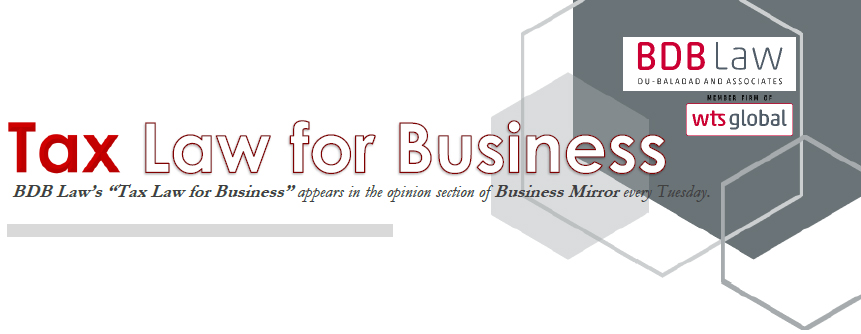
Mandatory Related Party Disclosure
By Atty. Irwin C. Nidea Jr.
"Why is the BIR mandating the filing of BIR Form 1709? It is understandable that the first document that is examined by the BIR to identify correct tax payment is the annual income tax return and financial statements."
The BIR is finding a way to capture related party transactions (RPT) by imposing mandatory tax filing of a BIR Form where taxpayers are required to disclose all RPTs. Revenue Regulation (RR) 19-2020 acknowledged that “transactions between related parties have become complex and have been subject to abuse by taxpayers with intent to evade taxes by concluding transactions between them at unreasonable prices.” By mandating the filing of BIR Form 709 every year, as an attachment to the Annual Income Tax Returns, taxpayers are now left with no choice but to comply.
What information must taxpayers disclose?
 According to the RR, the required disclosures must be made separately for each of the following categories: (i) the parent company; (ii) entities with joint control or significant influence over the entity; (iii) subsidiaries; (iv) associates; (v) joint ventures in which the entity is a joint venturer; (vi) key management personnel of the entity or its parent; and (vii) other related parties.
According to the RR, the required disclosures must be made separately for each of the following categories: (i) the parent company; (ii) entities with joint control or significant influence over the entity; (iii) subsidiaries; (iv) associates; (v) joint ventures in which the entity is a joint venturer; (vi) key management personnel of the entity or its parent; and (vii) other related parties.
The RR also provides that for each of the category mentioned above, the following information shall be provided: (i) the amount of the transactions; (ii) the amount of outstanding balances, including commitments, and their terms and conditions, including whether they are secured, and the nature of the consideration to be provided in settlement, and details of any guarantees given or received; (iii) provisions for doubtful debts related to the amount of outstanding balances; (iv) the expense recognized during the period in respect of bad or doubtful debts due from related parties.
This information will be used by the BIR to assess the total value of related party transactions and the nature of the transactions. The loan and debt disclosures for example, will be used to test if the company imposed interest rate at arm’s length.
It is also required that the nature of transactions is described in detail. The "business overview of the ultimate parent company" include the profile of the multinational group of which the taxpayer belongs, along with the name, address, legal status and country of tax residence of each of the related parties with whom intra-group transactions have been entered into by the taxpayer, and ownership linkages among them.
On the other hand, the "functional profile" shall include a broad description of the business of the taxpayer and the industry in which it operates, and of the business of the related parties with whom the taxpayer has transacted.
The following documents must also be attached: a) certified true copy of the relevant contracts or proof of transaction; b) withholding tax returns and the corresponding proof of payment of taxes withheld and remitted to the BIR; c) proof of payment of foreign taxes or ruling duly issued by the foreign tax authority where the other party is a resident; and d) certified true copy of Advance Pricing Agreement, if any; and e) any transfer pricing documentation.
the corresponding proof of payment of taxes withheld and remitted to the BIR; c) proof of payment of foreign taxes or ruling duly issued by the foreign tax authority where the other party is a resident; and d) certified true copy of Advance Pricing Agreement, if any; and e) any transfer pricing documentation.
The BIR wants to know the relationship between parent and sister companies, the extent of their contribution to each other’s businesses in terms of capital, management and control.
Why is the BIR mandating the filing of BIR Form 1709? It is understandable that the first document that is examined by the BIR to identify correct tax payment is the annual income tax return and financial statements. But these are not enough to identify transfer pricing compliance. By making disclosure mandatory through a BIR Form, taxpayers are now at risk of a criminal penalty if what are stated in the said tax return are false. The BIR is hoping that for fear of criminal prosecution, taxpayers will now think twice of not complying with the correct transfer price in its related party transactions.
When is BIR Form 1709 due for filing? The RR states that the Regulations shall take effect after fifteen (15) days following its publication in a newspaper of general circulation. So, if it was published on July 8, 2020, it will be effective on July 23, 2020. Thus, all Annual Income Tax Returns that will be filed starting July 23, 2020 must already attach BIR Form 1709.
What if a taxpayer fails to file BIR Form 709? The RR states that any violation of the provisions of this issuance shall be subject to penalties provided the Tax Code. It means failure to file a return which is at least equivalent to 1-year imprisonment.
The BIR is trying to catch up with the rest of the world in terms of transfer pricing compliance by using BIR Form 1709 as a tool. Taxpayers must take this seriously. This would require all conglomerates to tighten their controls on transfer pricing between their affiliates. Failure to do so would mean a domino of tax assessment falling one after the other.
The author is a senior partner of Du-Baladad and Associates Law Offices, a member-firm of WTS Global.
The article is for general information only and is not intended, nor should be construed as a substitute for tax, legal or financial advice on any specific matter. Applicability of this article to any actual or particular tax or legal issue should be supported therefore by a professional study or advice. If you have any comments or questions concerning the article, you may e-mail the author at This email address is being protected from spambots. You need JavaScript enabled to view it. or call 8403-2001 local 330.



